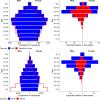Demographic science aids in understanding the spread and fatality rates of COVID-19
- PMID: 32300018
- PMCID: PMC7211934
- DOI: 10.1073/pnas.2004911117
Demographic science aids in understanding the spread and fatality rates of COVID-19
Abstract
Governments around the world must rapidly mobilize and make difficult policy decisions to mitigate the coronavirus disease 2019 (COVID-19) pandemic. Because deaths have been concentrated at older ages, we highlight the important role of demography, particularly, how the age structure of a population may help explain differences in fatality rates across countries and how transmission unfolds. We examine the role of age structure in deaths thus far in Italy and South Korea and illustrate how the pandemic could unfold in populations with similar population sizes but different age structures, showing a dramatically higher burden of mortality in countries with older versus younger populations. This powerful interaction of demography and current age-specific mortality for COVID-19 suggests that social distancing and other policies to slow transmission should consider the age composition of local and national contexts as well as intergenerational interactions. We also call for countries to provide case and fatality data disaggregated by age and sex to improve real-time targeted forecasting of hospitalization and critical care needs.
Keywords: COVID-19; age structure; demography; mortality.
Copyright © 2020 the Author(s). Published by PNAS.
Conflict of interest statement
The authors declare no competing interest.
Figures


Comment in
-
Besides population age structure, health and other demographic factors can contribute to understanding the COVID-19 burden.Proc Natl Acad Sci U S A. 2020 Jun 23;117(25):13881-13883. doi: 10.1073/pnas.2008760117. Proc Natl Acad Sci U S A. 2020. PMID: 32576710 Free PMC article. No abstract available.
References
-
- Novel Coronavirus Pneumonia Emergency Response Epidemiology , The epidemiological characteristics of an outbreak of 2019 novel coronavirus diseases (COVID-19) in China. Zhonghua Liu Xing Bing Xue Za Zhi. 41, 145–151 (2020). - PubMed
-
- Istituto Superiore di Sanità , Age specific mortality rates COVID-19. https://www.epicentro.iss.it/coronavirus/bollettino/Bollettino-sorveglia.... Accessed 31 March 2020.
-
- Salmon A., Why are Korea’s COVID-19 death rates so low? Asia Times, 11 March 2020. https://asiatimes.com/2020/03/why-are-koreas-covid-19-death-rates-so-low/. Accessed 13 March 2020.
-
- United Nations , World Population Prospects 2019. https://population.un.org/wpp/DataQuery/. Accessed 13 March 2020.
-
- Kalmijn M., Saraceno C., A comparative perspective on intergenerational support. Eur. Soc. 10, 479–508 (2008).
MeSH terms
LinkOut - more resources
Full Text Sources
Miscellaneous

